The Interface Microstructures and Mechanical Properties of Laser Additive Repaired Inconel 625 Alloy
Abstract
1. Introduction
2. Materials and Methods
2.1. Materials
2.2. Experimental Procedures
3. Results and Discussion
3.1. Microstructure Around the Repaired Interface
3.1.1. Grain Structures
3.1.2. Phases and Precipitations
3.1.3. Microstructure in the Overlapping Transition Zone
3.2. Composition Distribution
3.3. Mechanical Properties
3.3.1. Hardness
3.3.2. Tensile Tests
4. Conclusions
- The microstructure around the repaired interface of a LARed Inconel 625 alloy can be divided into three zones: the SZ, HAZ, and RZ. The SZ has a typical equiaxed crystal structure with a bimodal grain size distribution, while in the HAZ, recrystallization occurs and leads to significant grain growth. In the RZ, there are very large columnar grains, and the size of the columns increases with an increase in the number of deposited layers.
- The precipitates in the SZ mainly consist of large (approximately 10 μm) and small (approximately 0.5 μm) block-shaped MC-type carbides (M is Nb and Ti) and irregularly shaped flocculent Laves phase. In the HAZ, there are still many large block-shaped MC-type carbides, but some precipitates dissolve in the original grain boundaries. For the RZ, some Laves and few MC-type carbides are precipitated along the epitaxial growth dendritic boundaries.
- The microstructure between two adjacent deposited tracks presented an overlapping transition zone (OTZ), which the dendritic structure coarsened, and more Laves phase precipitated compared to in the layer interior. The width of the OTZ was approximately 0.15 mm. The lower G·R in the OTZ led to an increase in dendrite arm spacing and the formation of the Laves phase.
- The Vickers hardness and indentation modulus from the SZ to the RZ along the deposition direction were not notably different in the LARed samples, and were approximately 240 ± 20 HV. The microhardness of the matrix phase in the RZ (approximately 5.1 GPa) was slightly higher than that of the SZ (approximately 4.8 GPa), while the microhardness generally achieved a lower value (approximately 4.6 GPa) in the HAZ. In particular, the microhardness of the matrix phase in the OTZ was approximately 4.7 GPa, which was slightly lower than that of layer interior in the RZ (approximately 5.1 GPa). The fluctuation of the microhardness of the matrix phase around the repaired interface was mainly caused by the segregation of the Nb and Mo alloying elements.
- The yield strength and elastic modulus of the LARed samples were higher than those of the wrought sample. The tensile strength and ductility of the LARed samples were similar to those of the wrought sample. Both the SZ and RZ presented a dimple fracture surface, and a large number of secondary cracks could be found in the SZ. The dimples and tear edges had a clear orientation in the RZ. The comprehensive tensile properties of the LARed Inconel 625 alloy are equivalent to those of the wrought alloy.
Author Contributions
Funding
Conflicts of Interest
References
- Gao, Y.; Ding, Y.; Chen, J.; Xu, J.; Ma, Y.; Wang, X. Effect of Twin Boundaries on the Microstructure and Mechanical Properties of Inconel 625 Alloy. Mater. Sci. Eng. A 2019, 767, 138361. [Google Scholar] [CrossRef]
- Salarian, M.; Asgari, H.; Vlasea, M. Pore Space Characteristics and Corresponding Effect on Tensile Properties of Inconel 625 Fabricated Via Laser Powder Bed Fusion. Mater. Sci. Eng. A 2020, 769, 138525. [Google Scholar] [CrossRef]
- Hu, Y.L.; Lin, X.; Yu, X.B.; Xu, J.J.; Lei, M.; Huang, W.D. Effect of Ti Addition on Cracking and Microhardness of Inconel 625 During the Laser Solid Forming Processing. J. Alloys Compd. 2017, 711, 267–277. [Google Scholar] [CrossRef]
- Mostafaei, A.; Behnamian, Y.; Krimer, Y.L.; Stevens, E.L.; Luo, J.L.; Chmielus, M. Effect of Solutionizing and Aging on the Microstructure and Mechanical Properties of Powder Bed Binder Jet Printed Nickel-Based Superalloy 625. Mater. Des. 2016, 111, 482–491. [Google Scholar] [CrossRef]
- Nguejio, J.; Szmytka, F.; Hallais, S.; Tanguy, A.; Nardone, S.; Martinez, M.G. Comparison of Microstructure Features and Mechanical Properties for Additive Manufactured and Wrought Nickel Alloys 625. Mater. Sci. Eng. A 2019, 764, 138214. [Google Scholar] [CrossRef]
- Kumar, A.; Rajkumar, K.V.; Jayakumar, T.; Raj, B.; Mishra, B. Ultrasonic Measurements for in-Service Assessment of Wrought Inconel 625 Cracker Tubes of Heavy Water Plants. J. Nucl. Mater. 2006, 350, 284–292. [Google Scholar] [CrossRef]
- Debroy, T.; Wei, H.L.; Zuback, J.S.; Mukherjee, T.; Elmer, J.W.; Milewski, J.O.; Beese, A.M.; Wilson-Heid, A.; De, A.; Zhang, W. Additive Manufacturing of Metallic Components-Process, Structure and Properties. Prog. Mater. Sci. 2018, 92, 112–224. [Google Scholar] [CrossRef]
- Herzog, D.; Seyda, V.; Wycisk, E.; Emmelmann, C. Additive Manufacturing of Metals. Acta Mater. 2016, 117, 371–392. [Google Scholar] [CrossRef]
- Sui, S.; Chen, J.; Zhang, R.; Ming, X.; Liu, F.; Lin, X. The Tensile Deformation Behavior of Laser Repaired Inconel 718 with a Non-Uniform Microstructure. Mater. Sci. Eng. A 2017, 688, 480–487. [Google Scholar] [CrossRef]
- Onuike, B.; Bandyopadhyay, A. Additive Manufacturing in Repair: Influence of Processing Parameters on Properties of Inconel 718. Mater. Lett. 2019, 252, 256–259. [Google Scholar] [CrossRef]
- Zhao, Z.; Chen, J.; Tan, H.; Lin, X.; Huang, W. Evolution of Plastic Deformation and its Effect on Mechanical Properties of Laser Additive Repaired Ti64Eli Titanium Alloy. Opt. Laser Technol. 2017, 92, 36–43. [Google Scholar] [CrossRef]
- Balasubramanian, V.; Ravisankar, V.; Reddy, G.M. Effect of Pulsed Current and Post Weld Aging Treatment on Tensile Properties of Argon Arc Welded High Strength Aluminium Alloy. Mater. Sci. Eng. A 2007, 459, 19–34. [Google Scholar] [CrossRef]
- Liu, H.; Wang, X.; Ji, H. Fabrication of Lotus-Leaf-Like Superhydrophobic Surfaces Via Ni-Based Nano-Composite Electro-Brush Plating. Appl. Surf. Sci. 2014, 288, 341–348. [Google Scholar] [CrossRef]
- Pawlowski, L. Finely Grained Nanometric and Submicrometric Coatings by Thermal Spraying: A Review. Surf. Coat. Technol. 2008, 202, 4318–4328. [Google Scholar] [CrossRef]
- Saboori, A.; Aversa, A.; Marchese, G.; Biamino, S.; Lombardi, M.; Fino, P. Application of Directed Energy Deposition-Based Additive Manufacturing in Repair. Appl. Sci. 2019, 9, 3316. [Google Scholar] [CrossRef]
- Lin, X.; Cao, Y.; Wu, X.; Yang, H.; Chen, J.; Huang, W. Microstructure and Mechanical Properties of Laser Forming Repaired 17-4Ph Stainless Steel. Mater. Sci. Eng. A 2012, 553, 80–88. [Google Scholar] [CrossRef]
- Sun, S.D.; Liu, Q.; Brandt, M.; Luzin, V.; Cottam, R.; Janardhana, M.; Clark, G. Effect of Laser Clad Repair on the Fatigue Behaviour of Ultra-High Strength Aisi 4340 Steel. Mater. Sci. Eng. A 2014, 606, 46–57. [Google Scholar] [CrossRef]
- Liu, Q.; Wang, Y.; Zheng, H.; Tang, K.; Li, H.; Gong, S. Tc17 Titanium Alloy Laser Melting Deposition Repair Process and Properties. Opt. Laser. Technol. 2016, 82, 1–9. [Google Scholar] [CrossRef]
- Puppala, G.; Moitra, A.; Sathyanarayanan, S.; Kaul, R.; Sasikala, G.; Prasad, R.C.; Kukreja, L.M. Evaluation of Fracture Toughness and Impact Toughness of Laser Rapid Manufactured Inconel-625 Structures and their Co-Relation. Mater. Des. 2014, 59, 509–515. [Google Scholar] [CrossRef]
- Li, C.; White, R.; Fang, X.Y.; Weaver, M.; Guo, Y.B. Microstructure Evolution Characteristics of Inconel 625 Alloy from Selective Laser Melting to Heat Treatment. Mater. Sci. Eng. A 2017, 705, 20–31. [Google Scholar] [CrossRef]
- Wang, P.; Zhang, B.; Tan, C.C.; Raghavan, S.; Lim, Y.; Sun, C.; Wei, J.; Chi, D. Microstructural Characteristics and Mechanical Properties of Carbon Nanotube Reinforced Inconel 625 Parts Fabricated by Selective Laser Melting. Mater. Des. 2016, 112, 290–299. [Google Scholar] [CrossRef]
- Kreitcberg, A.; Brailovski, V.; Turenne, S. Effect of Heat Treatment and Hot Isostatic Pressing on the Microstructure and Mechanical Properties of Inconel 625 Alloy Processed by Laser Powder Bed Fusion. Mater. Sci. Eng. A 2017, 689, 1–10. [Google Scholar] [CrossRef]
- Dinda, G.P.; Dasgupta, A.K.; Mazumder, J. Laser Aided Direct Metal Deposition of Inconel 625 Superalloy: Microstructural Evolution and Thermal Stability. Mater. Sci. Eng. A 2009, 509, 98–104. [Google Scholar] [CrossRef]
- Rombouts, M.; Maes, G.; Mertens, M.; Hendrix, W. Laser Metal Deposition of Inconel 625: Microstructure and Mechanical Properties. J. Laser Appl. 2012, 24, 2575–2581. [Google Scholar] [CrossRef]
- Rivera, O.G.; Allison, P.G.; Jordon, J.B.; Rodriguez, O.L.; Brewer, L.N.; McClelland, Z.; Whittington, W.R.; Francis, D.; Su, J.; Martens, R.L. Microstructures and Mechanical Behavior of Inconel 625 Fabricated by Solid-State Additive Manufacturing. Mater. Sci. Eng. A 2017, 694, 1–9. [Google Scholar] [CrossRef]
- Tian, Y.; Ouyang, B.; Gontcharov, A.; Gauvin, R.; Lowden, P.; Brochu, M. Microstructure Evolution of Inconel 625 with 0.4 Wt% Boron Modification During Gas Tungsten Arc Deposition. J. Alloys Compd. 2017, 694, 429–438. [Google Scholar] [CrossRef]
- Xu, F.J.; Lv, Y.H.; Xu, B.S.; Liu, Y.X.; Shu, F.Y.; He, P. Effect of Deposition Strategy on the Microstructure and Mechanical Properties of Inconel 625 Superalloy Fabricated by Pulsed Plasma Arc Deposition. Mater. Des. 2013, 45, 446–455. [Google Scholar] [CrossRef]
- Xu, X.; Mi, G.; Chen, L.; Xiong, L.; Jiang, P.; Shao, X.; Wang, C. Research on Microstructures and Properties of Inconel 625 Coatings Obtained by Laser Cladding with Wire. J. Alloys Compd. 2017, 715, 362–373. [Google Scholar] [CrossRef]
- Hu, X.; Xue, Z.; Zhao, G.; Yun, J.; Shi, D.; Yang, X. Laser Welding of a Selective Laser Melted Ni-Base Superalloy: Microstructure and High Temperature Mechanical Property. Mater. Sci. Eng. A 2019, 745, 335–345. [Google Scholar] [CrossRef]
- Xu, X.; Lin, X.; Yang, M.; Chen, J.; Huang, W. Microstructure Evolution in Laser Solid Forming of Ti-50Wt% Ni Alloy. J. Alloys Compd. 2009, 480, 782–787. [Google Scholar] [CrossRef]
- Wang, J.F.; Sun, Q.J.; Wang, H.; Liu, J.P.; Feng, J.C. Effect of Location on Microstructure and Mechanical Properties of Additive Layer Manufactured Inconel 625 Using Gas Tungsten Arc Welding. Mater. Sci. Eng. A 2016, 676, 395–405. [Google Scholar] [CrossRef]
- Kurz, W.; Fisher, D.J. Dendrite Growth at the Limit of Stability: Tip Radius and Spacing. Acta Metall. 1981, 29, 11–20. [Google Scholar] [CrossRef]
- Lin, X.; Yue, T.M.; Yang, H.O.; Huang, W.D. Laser Rapid Forming of Ss316L/Rene88Dt Graded Material. Mater. Sci. Eng. A 2005, 391, 325–336. [Google Scholar] [CrossRef]
- Collins, P.C.; Brice, D.A.; Samimi, P.; Ghamarian, I.; Fraser, H.L. Microstructural Control of Additively Manufactured Metallic Materials. Annu. Rev. Mater. Res. 2016, 46, 63–91. [Google Scholar] [CrossRef]
- Ram, G.D.J.; Reddy, A.V.; Rao, K.P.; Reddy, G.M. Improvement in Stress Rupture Properties of Inconel 718 Gas Tungsten Arc Welds Using Current Pulsing. J. Mater. Sci. 2005, 40, 1497–1500. [Google Scholar] [CrossRef]
- Oliver, W.C.; Pharr, G.M. An Improved Technique for Determining Hardness and Elastic Modulus Using Load and Displacement Sensing Indentation Experiments. J. Mater. Res. 1992, 7, 1564–1583. [Google Scholar] [CrossRef]
- Yu, L.; Wang, W.; Su, B.; Wang, Z.; Qu, F.; Wu, H.; Pu, Z.; Meng, X.; Wang, Q.; Wang, J.; et al. Characterizations on the Microstructure and Micro-Mechanics of Cast be-Al-0.4Sc-0.4Zr Alloy Prepared by Vacuum Induction Melting. Mater. Sci. Eng. A 2019, 744, 512–524. [Google Scholar] [CrossRef]
- Kumar, A.; Jayakumar, T.; Raj, B.; Ray, K.K. Correlation Between Ultrasonic Shear Wave Velocity and Poisson’S Ratio for Isotropic Solid Materials. Acta Mater. 2003, 51, 2417–2426. [Google Scholar] [CrossRef]
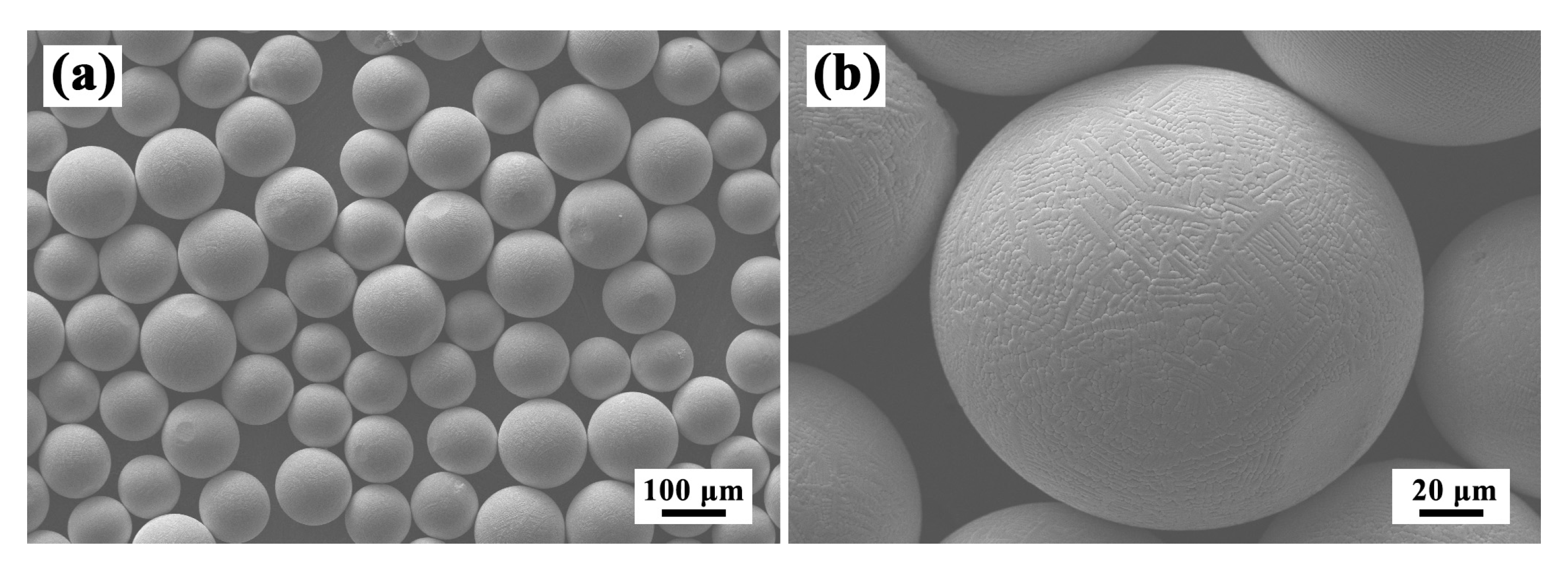



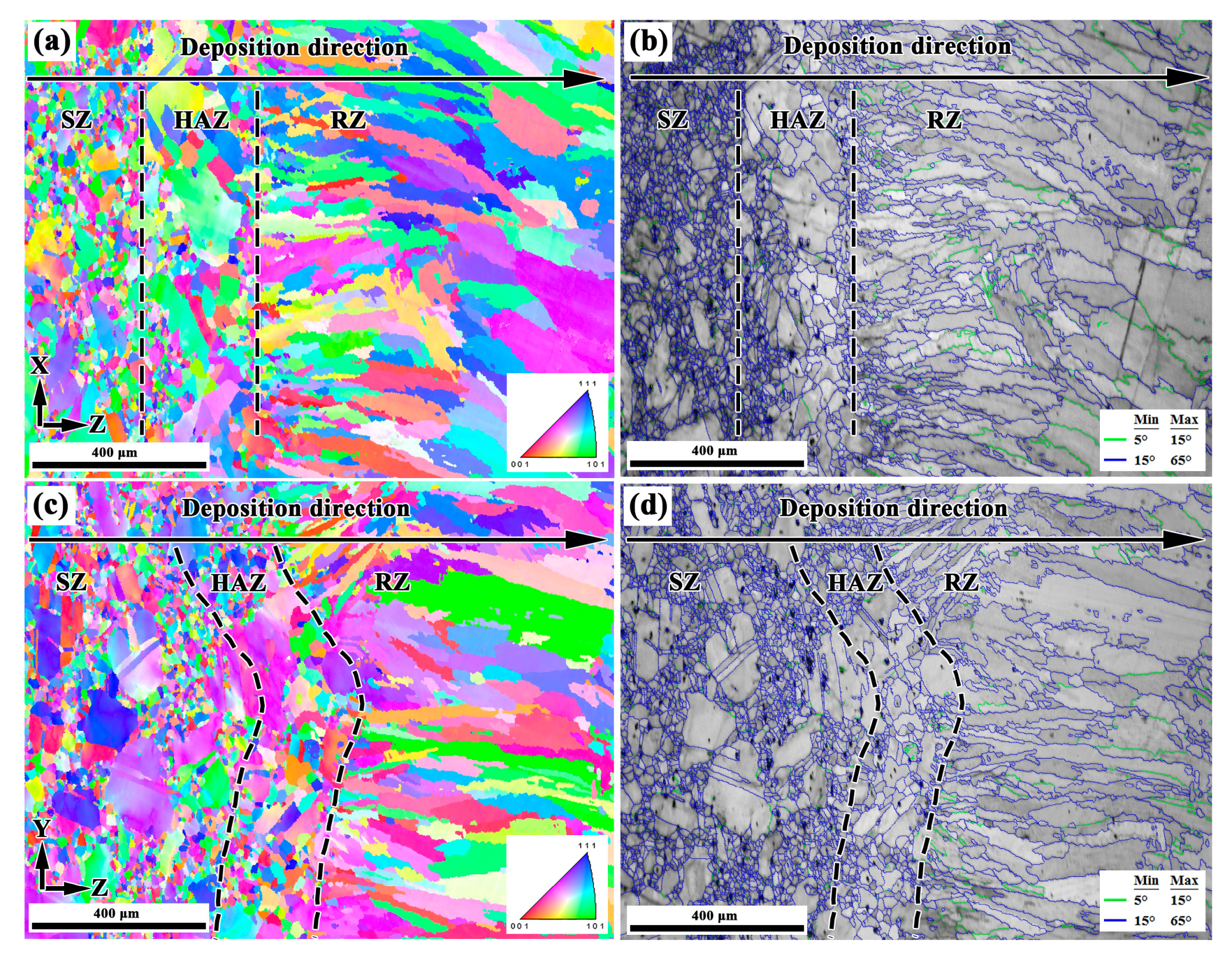
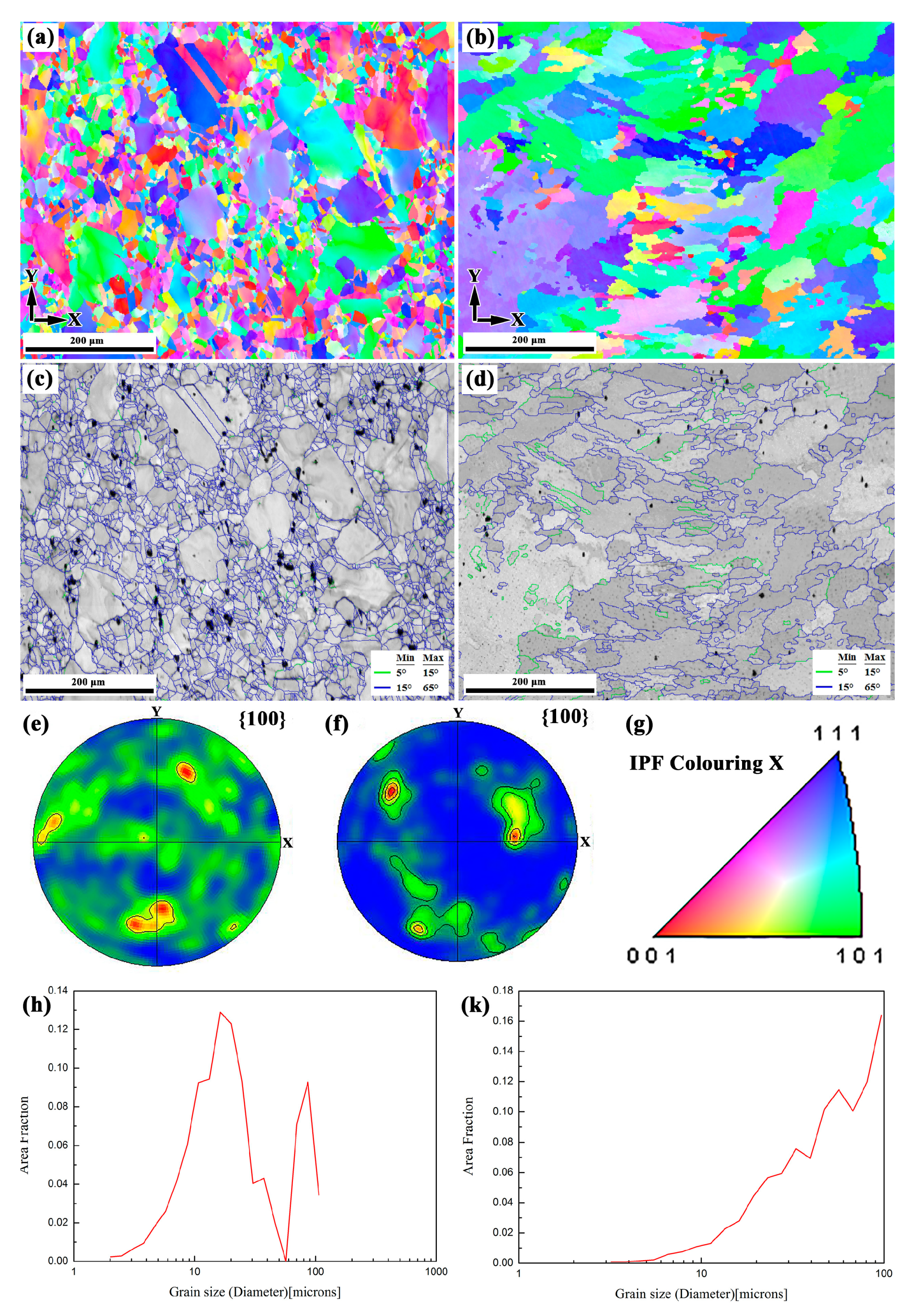
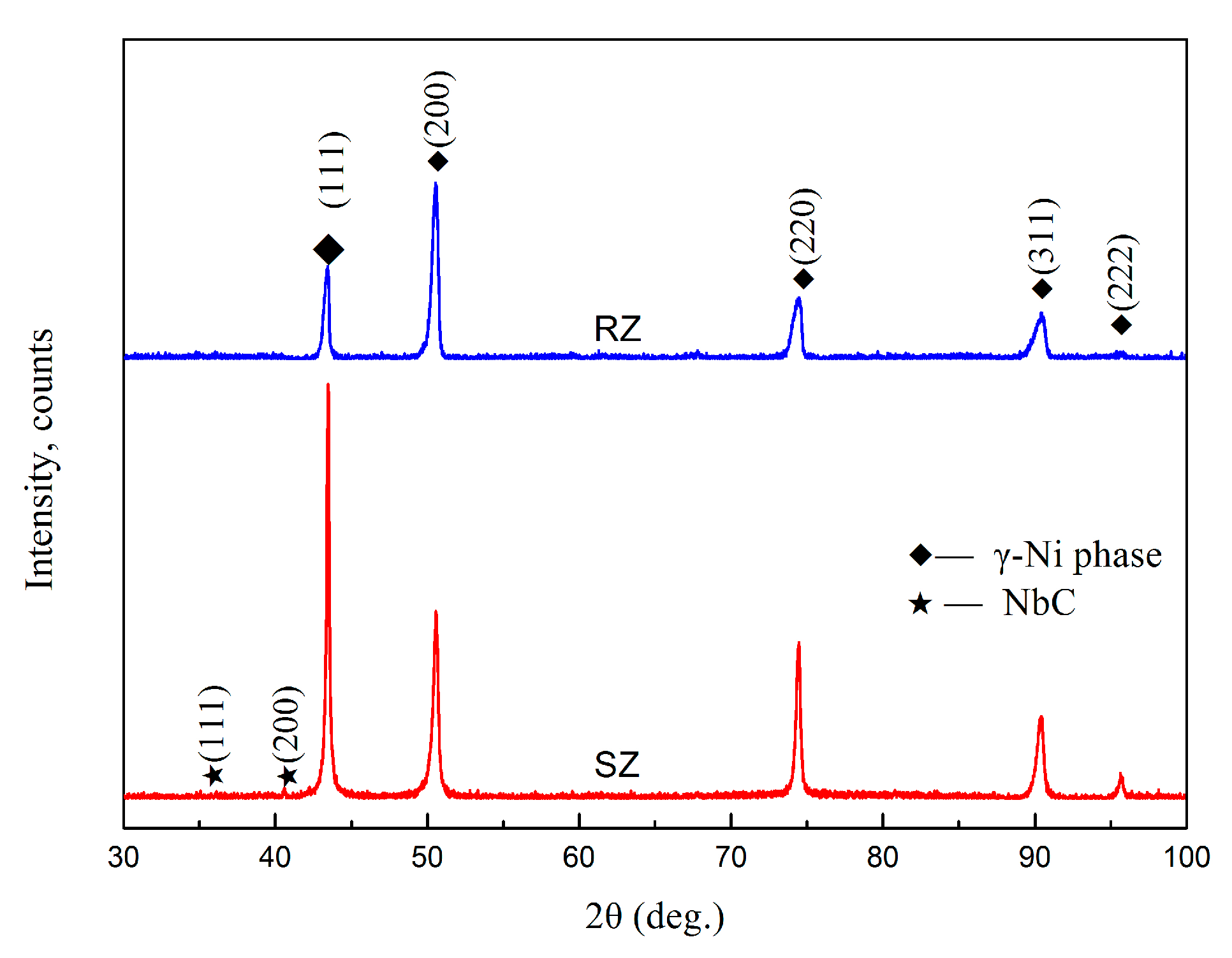
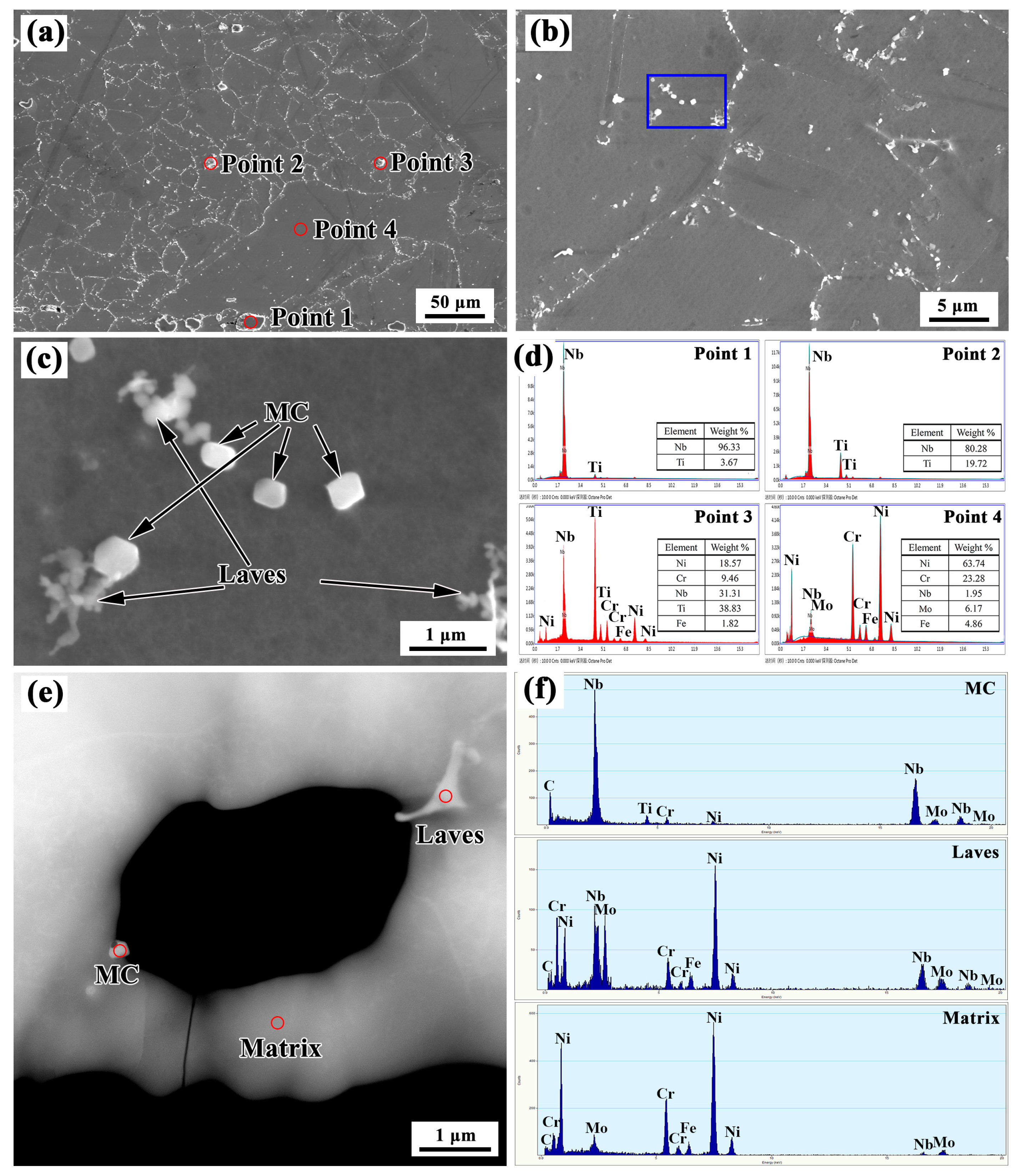
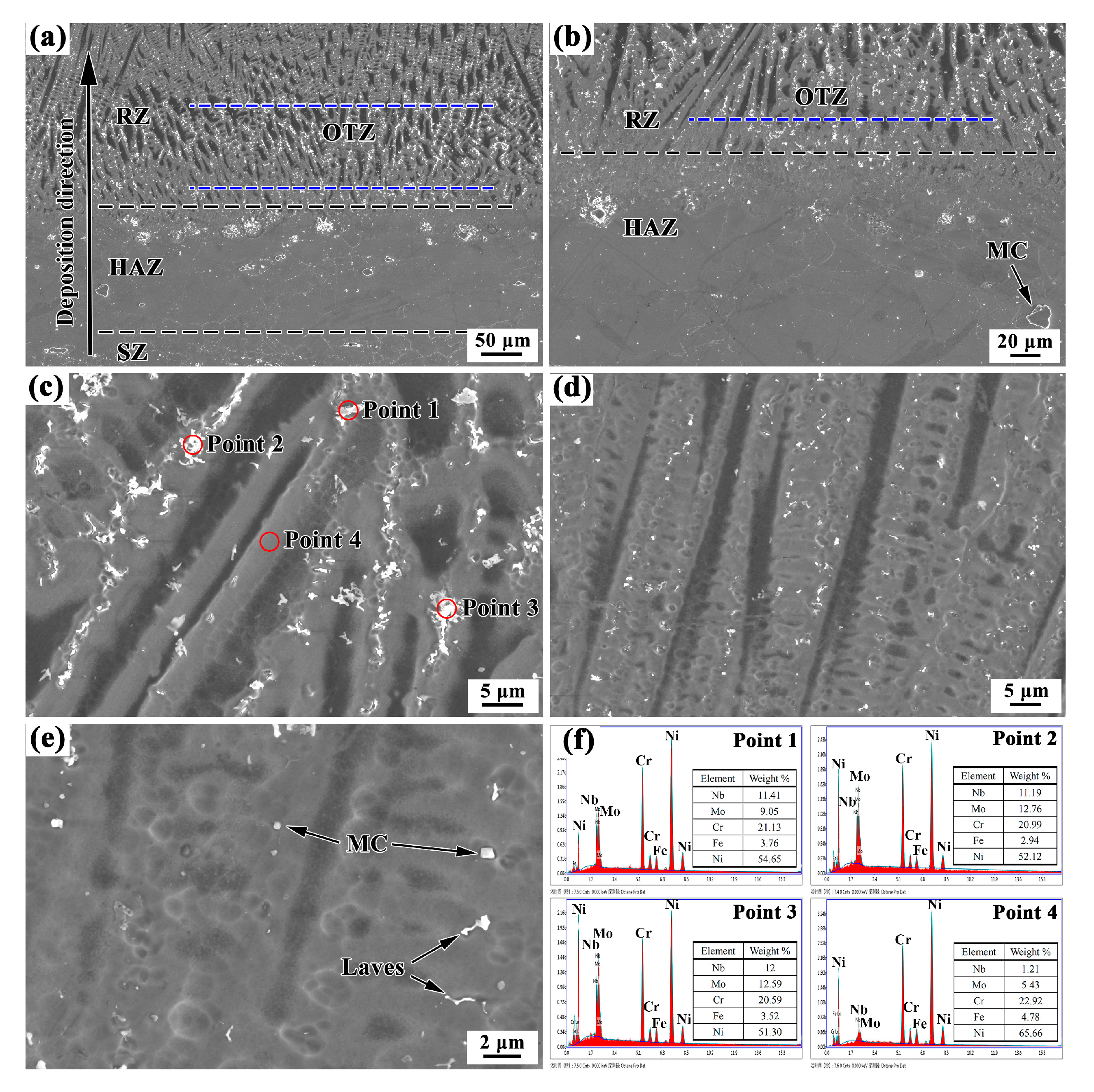
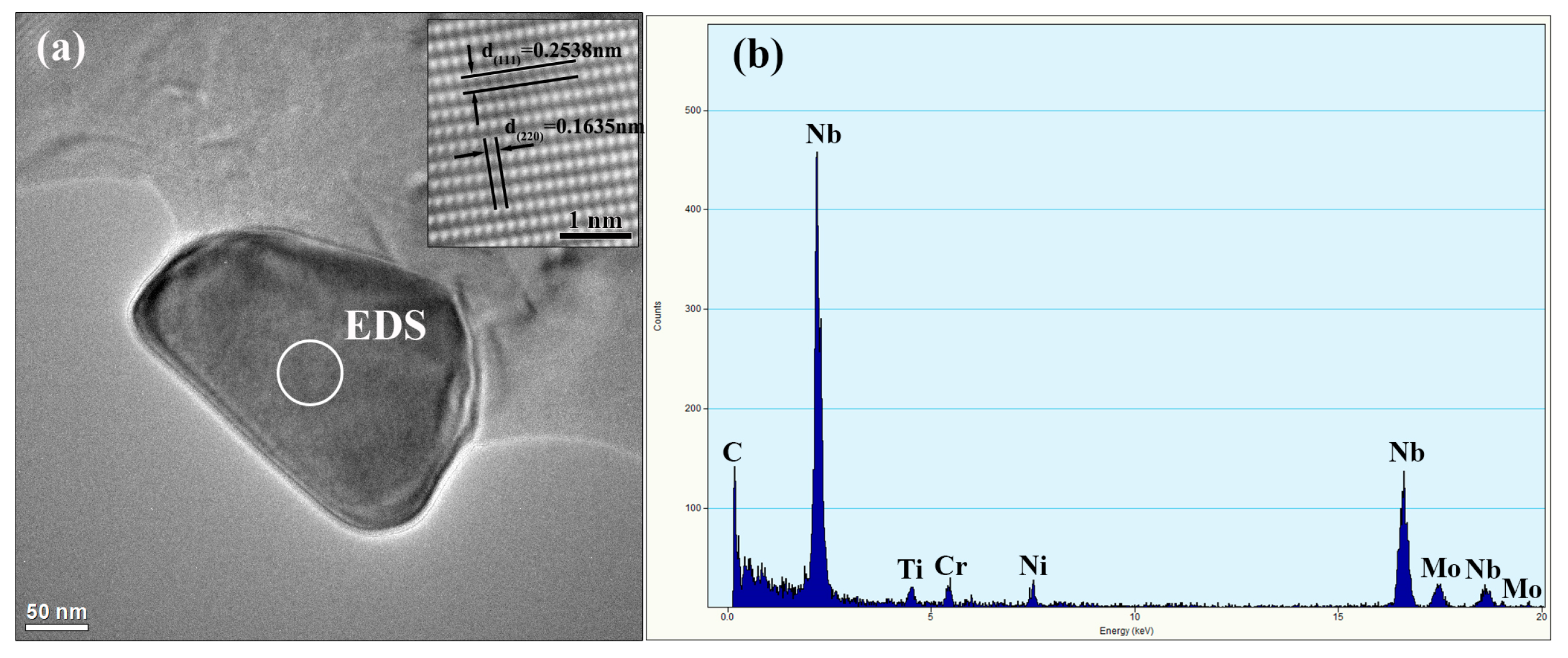
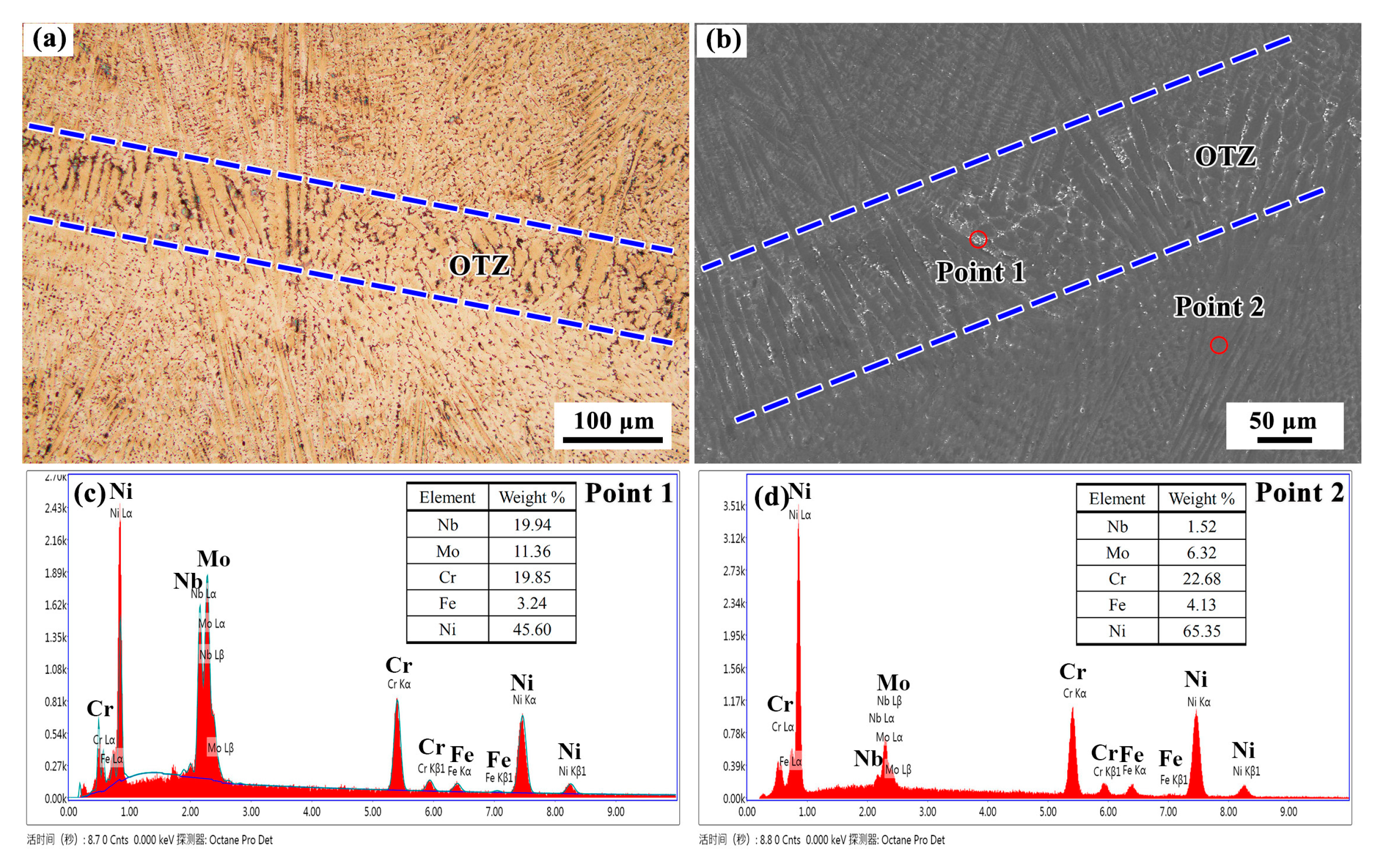

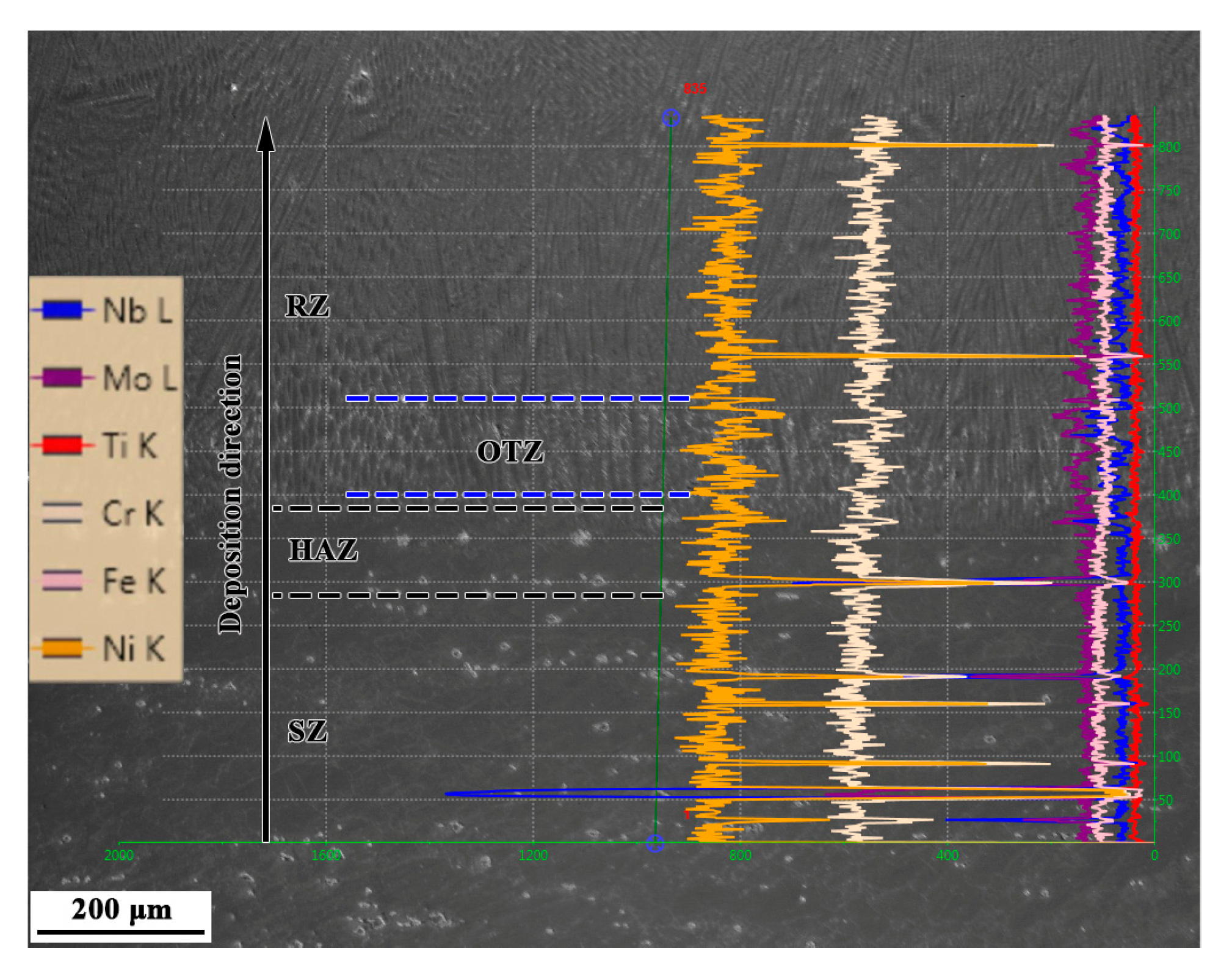
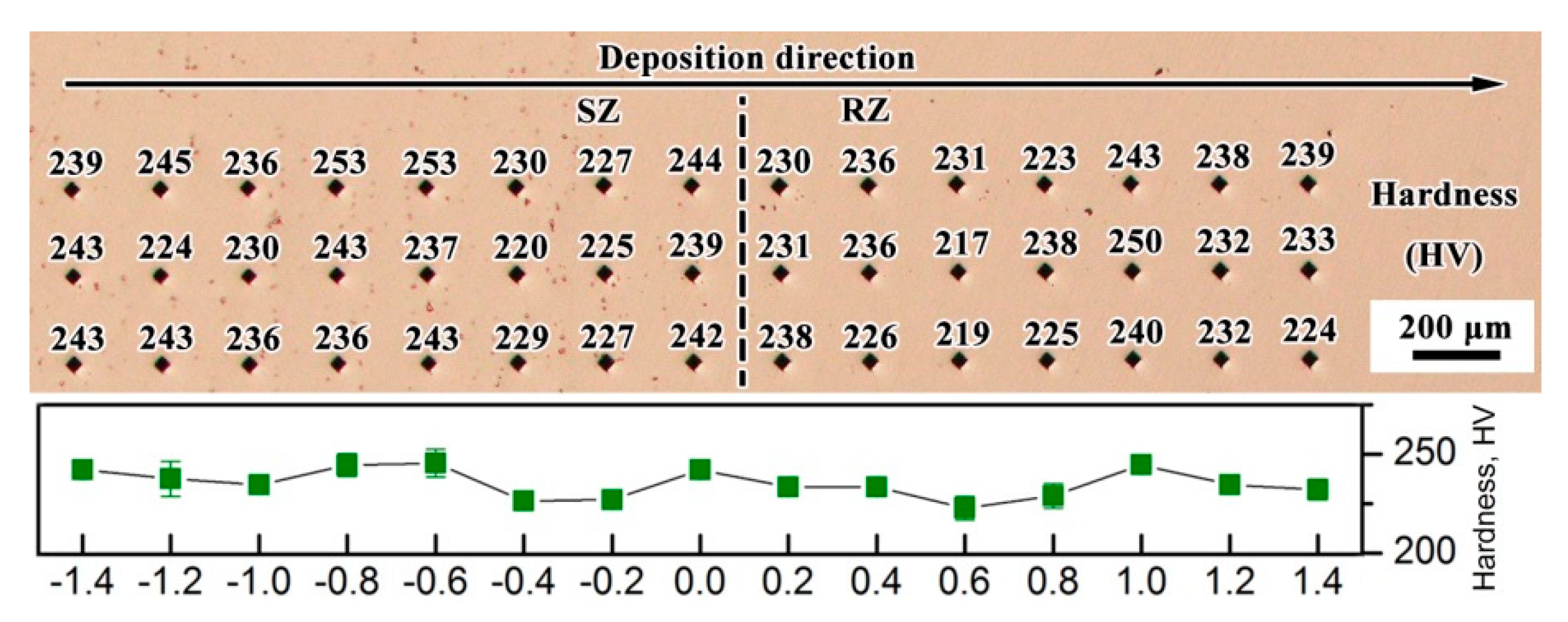

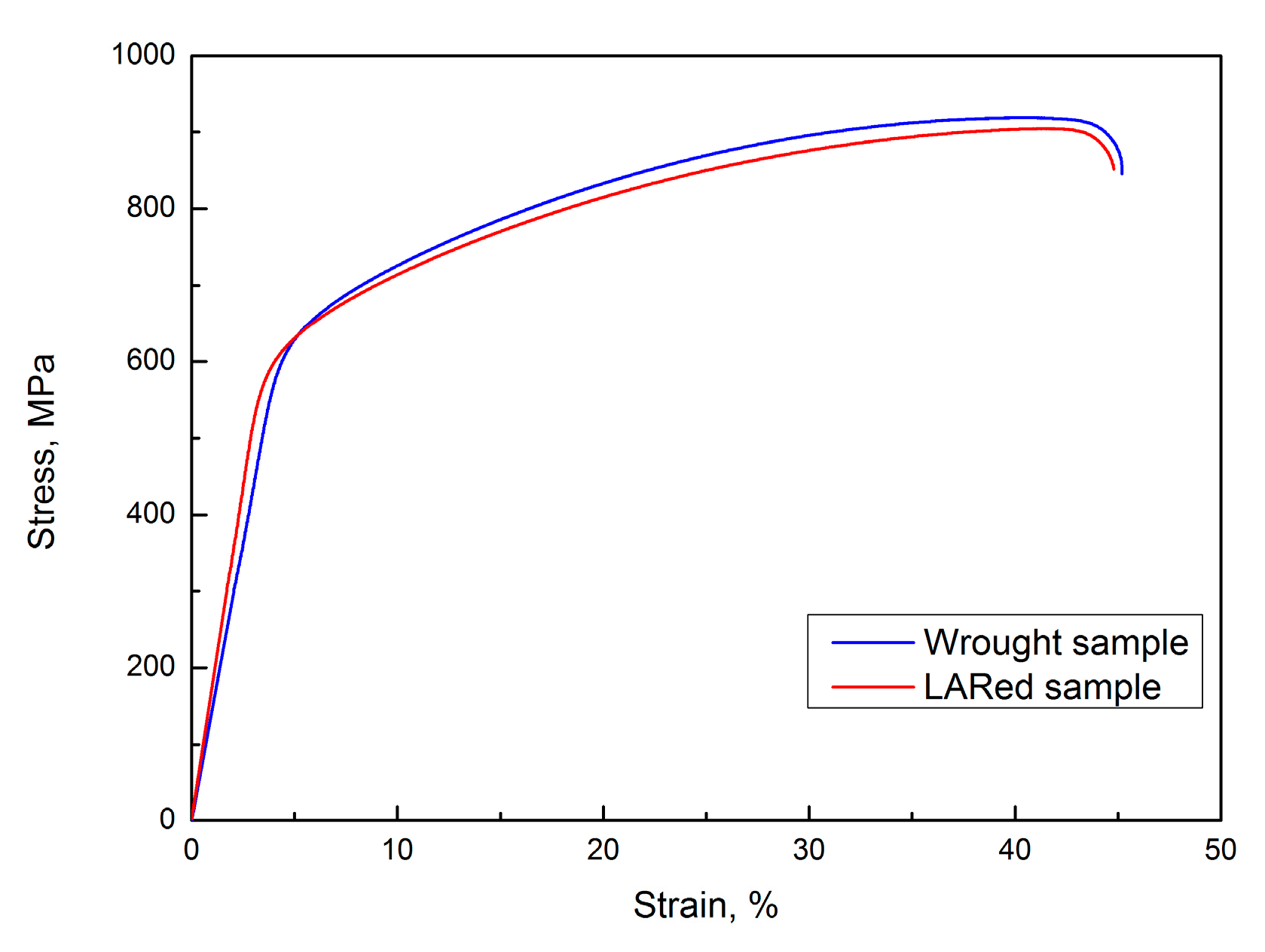
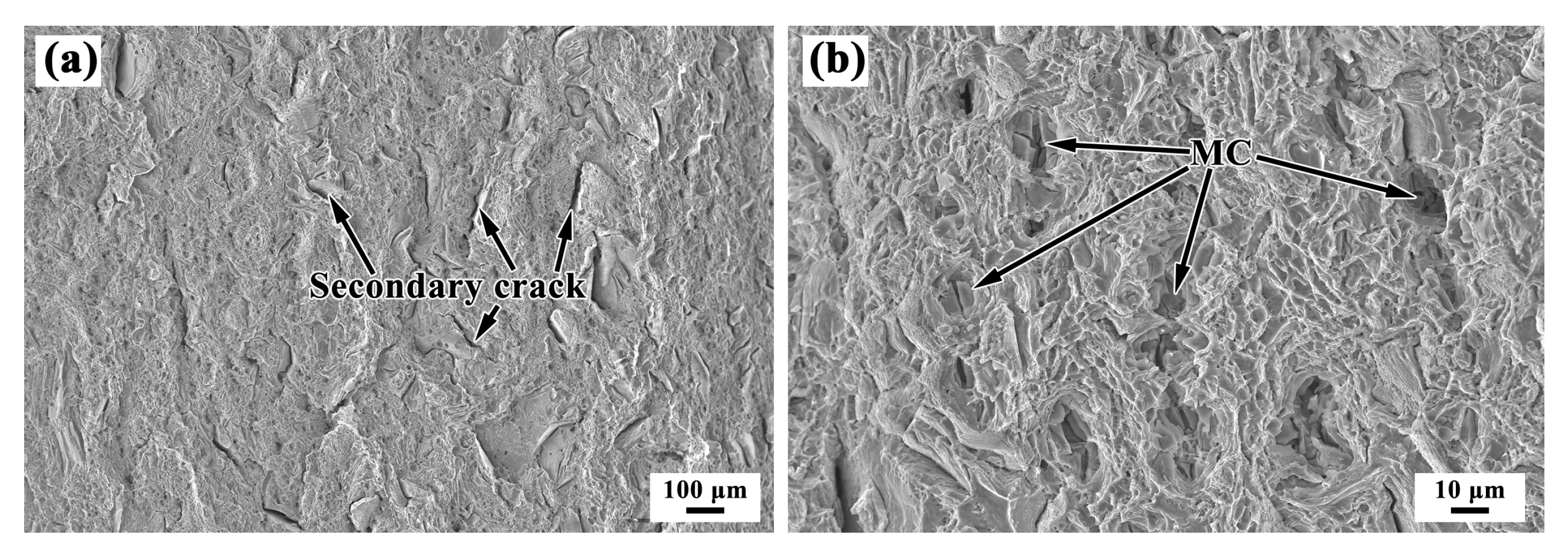
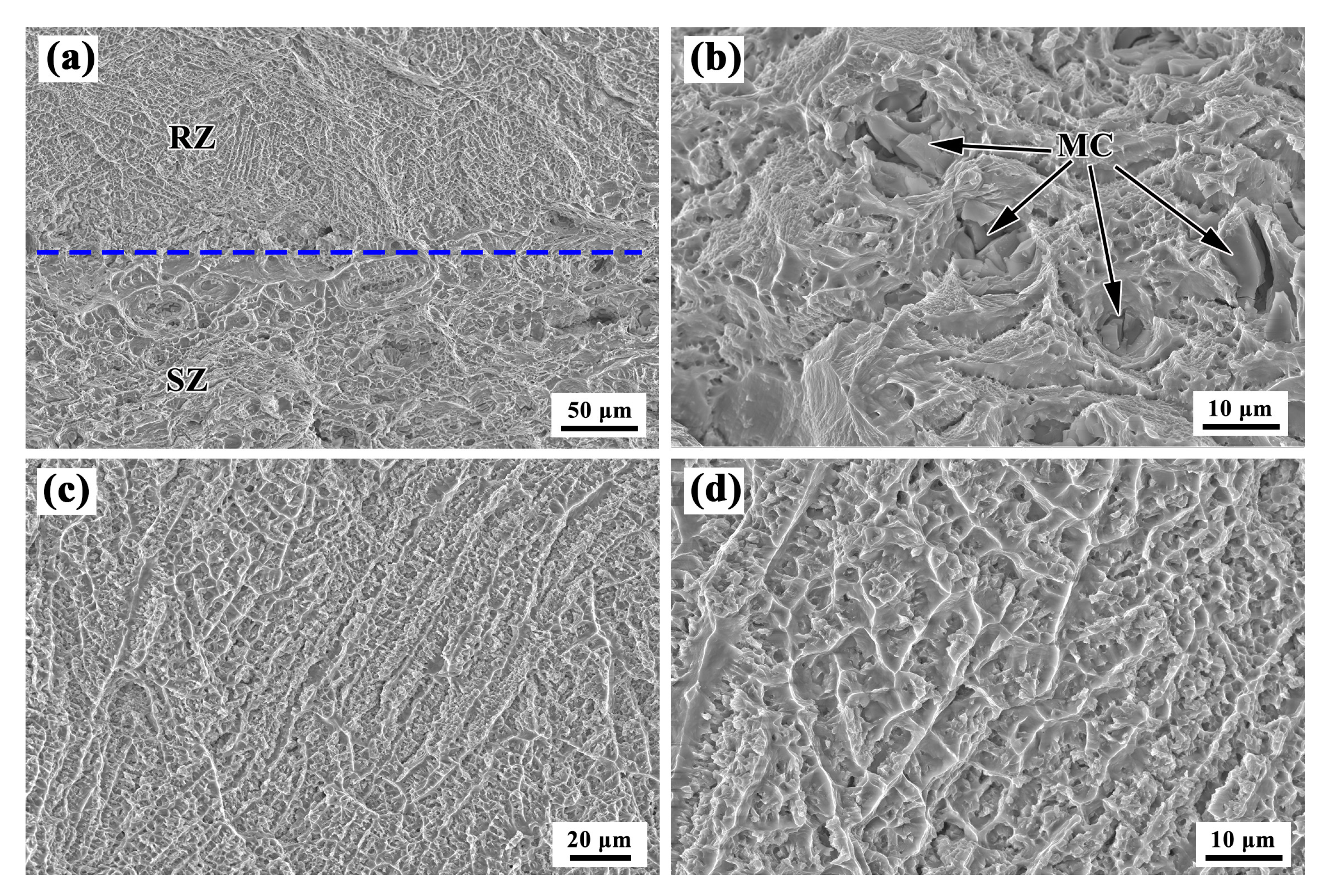
| Material | Ni | Cr | Mo | Nb | Fe | Ti | Al | C | Co | Mn | Si | P |
|---|---|---|---|---|---|---|---|---|---|---|---|---|
| Powder | Bal. | 21.92 | 9.09 | 3.62 | 3.71 | 0.20 | 0.17 | 0.036 | 0.009 | 0.015 | 0.06 | 0.003 |
| Substrate | Bal. | 21.70 | 8.90 | 3.27 | 4.40 | 0.18 | 0.12 | 0.030 | 0.010 | 0.170 | 0.15 | 0.008 |
| Laser Power (kW) | Scanning Speed (mm/min) | Laser Spot Diameter (mm) | Increment of Z Axis (mm) | Powder Feeder Rate (g/min) | Overlaps (%) |
|---|---|---|---|---|---|
| 1.4 | 400 | 3 | 0.5 | 6 | 45 |
| Number | Ultimate Tensile Strength σb (Mpa) | Yield Strength σ0.2 (Mpa) | Elongation δ (%) | Area Reduction Ψ (%) |
|---|---|---|---|---|
| LARed sample | 908 ± 5 | 587 ± 3 | 44.7 ± 0.5 | 45.0 ± 0.7 |
| Wrought substrate | 914 ± 4 | 572 ± 6 | 45.3 ± 0.4 | 43.7 ± 0.3 |
© 2020 by the authors. Licensee MDPI, Basel, Switzerland. This article is an open access article distributed under the terms and conditions of the Creative Commons Attribution (CC BY) license (http://creativecommons.org/licenses/by/4.0/).
Share and Cite
Wei, Y.; Le, G.; Xu, Q.; Yang, L.; Li, R.; Wang, W. The Interface Microstructures and Mechanical Properties of Laser Additive Repaired Inconel 625 Alloy. Materials 2020, 13, 4416. https://doi.org/10.3390/ma13194416
Wei Y, Le G, Xu Q, Yang L, Li R, Wang W. The Interface Microstructures and Mechanical Properties of Laser Additive Repaired Inconel 625 Alloy. Materials. 2020; 13(19):4416. https://doi.org/10.3390/ma13194416
Chicago/Turabian StyleWei, Yiyun, Guomin Le, Qingdong Xu, Lei Yang, Ruiwen Li, and Wenyuan Wang. 2020. "The Interface Microstructures and Mechanical Properties of Laser Additive Repaired Inconel 625 Alloy" Materials 13, no. 19: 4416. https://doi.org/10.3390/ma13194416
APA StyleWei, Y., Le, G., Xu, Q., Yang, L., Li, R., & Wang, W. (2020). The Interface Microstructures and Mechanical Properties of Laser Additive Repaired Inconel 625 Alloy. Materials, 13(19), 4416. https://doi.org/10.3390/ma13194416




